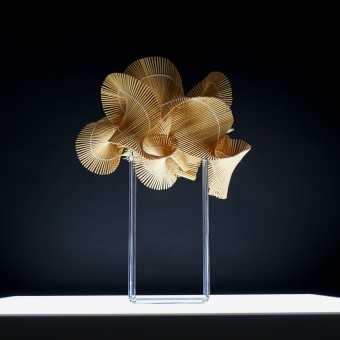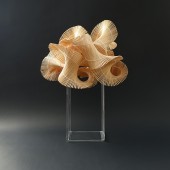
| THE AWARD |
| CATEGORIES |
| REGISTRATION |
| SUBMIT YOUR WORK |
| ENTRY INSTRUCTIONS |
| TERMS & CONDITIONS |
| PUBLICATIONS |
| DATES & FEES |
| METHODOLOGY |
| CONTACT |
| WINNERS |
| PRESS ROOM |
| GET INVOLVED |
| DESIGN PRIZE |
| DESIGN STORE |
| THE AWARD | JURY | CATEGORIES | REGISTRATION | PRESS | WINNERS | PUBLICATIONS | ENTRY INSTRUCTIONS |
Wood Storm Desktop Installation by Naai-Jung Shih |
Home > Winners > Design #64066 >Interview |
 |
|
FS: What is the main principle, idea and inspiration behind your design?
NS: The concept of this design originated from the rolling configuration of cloud in a storm. The powerful force of Mother Nature is so vivid that it has created an image of the tumbling dynamics. The lights and shadows seem switching constantly. The type of force needs to be captured and frozen into a solid form.
FS: What has been your main focus in designing this work? Especially what did you want to achieve?
NS: This installation is intended to be displayed statically. The interaction is made possible by guiding the line of sight around it to seek for the beginning or end point as the audiences actually experience the storm.
FS: What are your future plans for this award winning design?
NS: Promote it, sale it, or keep developing it in different scales, materials, or under different themes.
FS: How long did it take you to design this particular concept?
NS: This project started as early as 2015 in Taipei. A various types of material were applied in several on-and-off preliminary tests. The wood blind or curtain was assembled in 2017. The duration was about one month with intensive works.
FS: Why did you design this particular concept? Was this design commissioned or did you decide to pursuit an inspiration?
NS: This design is not commissioned and acts as a pursuit of an inspiration.
FS: Is your design being produced or used by another company, or do you plan to sell or lease the production rights or do you intent to produce your work yourself?
NS: This design was not produced or used by another company. To sell or lease related production rights are welcome, although I prefer to produce this work myself.
FS: What made you design this particular type of work?
NS: A dynamic interpretation of geometries and spaces is always the focus of my design. This is a pursuit of an inspiration and re-interpretation of a form that has been in my mind for a while.
FS: Where there any other designs and/or designers that helped the influence the design of your work?
NS: No other designs and designers that helped the influence the design of my work.
FS: Who is the target customer for his design?
NS: The potential target customers include interior designers and architects to be added as part of design or decoration, or for private collectors for personal collections.
FS: What sets this design apart from other similar or resembling concepts?
NS: There might be design with similar concepts, but it’s the manner of interpretation in terms of configuration that makes difference.
FS: How did you come up with the name for this design? What does it mean?
NS: The name and design execution interacts with each other. Wood Storm refers the violent interaction between a tree and a storm. When the installation is present as floating in the air, the piece of abstraction is encapsulated.
FS: Which design tools did you use when you were working on this project?
NS: The form was explored manually. No specific design technology was applied.
FS: What is the most unique aspect of your design?
NS: The tumbling nature of storm cloud is now substantiated by a piece of rolling wood curtain and can be set up on desktop or any flat surface with lights casted from below. The individual linear wood or bamboo element creates a marching effect. The intermediate layout let people see the depth of space in a storm. The U-shaped transparent base is selected purposely to make the storm look like floating and expanding in the air.
FS: Who did you collaborate with for this design? Did you work with people with technical / specialized skills?
NS: Nobody collaborates with me for this design.
FS: What is the role of technology in this particular design?
NS: Wood curtain was used to represent the turbulence of air and give the storm a warm touch. Two levels of deployment were applied to create a typical vocabulary for the curtain surface by axial twist and circular roll. The smaller width of curtain was selected purposely to enable the void channels opened up from different orientations.
FS: Is your design influenced by data or analytical research in any way? What kind of research did you conduct for making this design?
NS: Researches were made to the composition of materials or elements with sufficient strength and continuous effect to ensure a smooth and turbulent visual order.
FS: What are some of the challenges you faced during the design/realization of your concept?
NS: The most challenging part of all was to create a twist vocabulary that let the edges and bodies of the curtain being self-supported. The curtain was personal favorite but not the first choice because its stiffness was not sufficient enough to show the tension of flow. The final choice was the curtain of 12 cm wide in two threads. Other types of curtain were tested as 30 cm wide and 200 cm long in 12 threads. The diameter of each linear bamboo element is 2 mm. The combination of the diameter, width, and length created a smooth transaction of surface.
FS: How did you decide to submit your design to an international design competition?
NS: It is a self-promoting or self-evolving process to become part of an international design competition.
FS: What did you learn or how did you improve yourself during the designing of this work?
NS: A design work was improved through stages of development in a recursive loop of examination under different scales. That’s why some design works were made more than one year.
FS: Any other things you would like to cover that have not been covered in these questions?
NS: There is always issue to be addressed. Let’s keep it open for next year or next competition.
FS: Thank you for providing us with this opportunity to interview you.
A' Design Award and Competitions grants rights to press members and bloggers to use parts of this interview. This interview is provided as it is; DesignPRWire and A' Design Award and Competitions cannot be held responsible for the answers given by participating designers.
| SOCIAL |
| + Add to Likes / Favorites | Send to My Email | Comment | View Press-Release | Translations |




